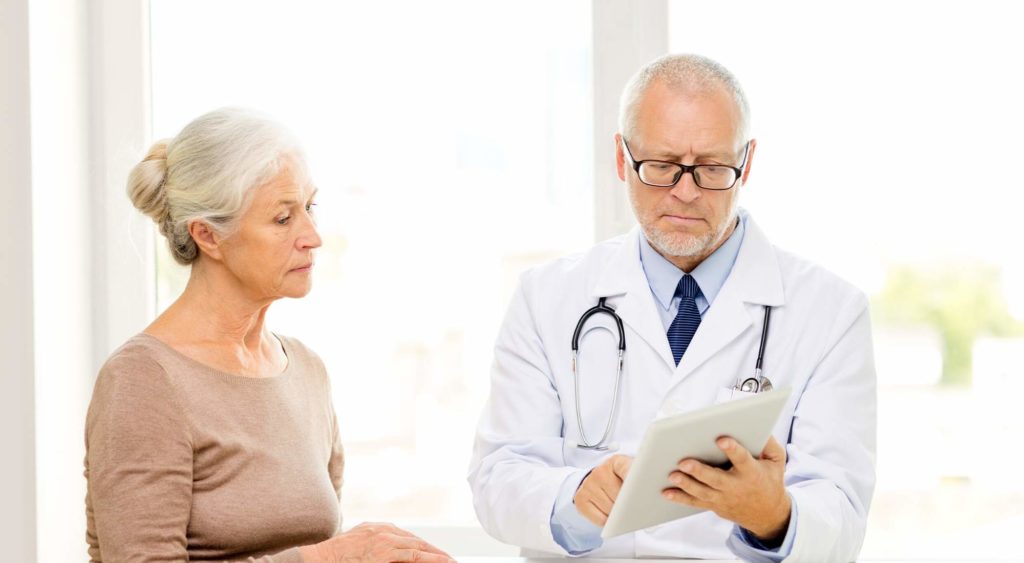Parkinsons Physical Therapy

Physical Therapy for Parkinson’s – Information, Exercises, and More
A diagnosis of Parkinson’s disease can be overwhelming.
You may feel frustrated with your symptoms and feel like you are losing your faculties.
Thankfully, there are many treatment options that can often drastically improve Parkinson’s disease symptoms.
In this guide, we will talk about the signs and symptoms of Parkinson’s disease and what treatment options may be available to you.

What is Parkinson’s?
Parkinson’s is a progressive neurodegenerative disorder that affects body movement.
Parkinson’s is caused by the gradual breakdown or death of dopamine-producing neurons.
The decrease in dopamine causes abnormal brain activity which ultimately leads to Parkinson’s symptoms.
Early stages of Parkinson’s often present with:
- Reduced or complete loss of facial expressions
- Soft or slurred speech
- Stiffness or slowing of movement
- A slight tremor in one hand
Over time, the disease gradually worsens and begins to affect the entire body.
Studies show Parkinson’s is the second-most common neurodegenerative disorder affecting adults in America.
What Causes Parkinson’s?
The cause of Parkinson’s disease is unknown.
However, several factors seem to play a role in disease development:
- Genetics. Specific gene mutations have been linked to the development of Parkinson’s. However, these mutations are uncommon with the exception of rare cases where many family members develop Parkinson’s.
- Environmental factors. Although the risk is small, exposure to certain toxins or other environmental factors can increase the risk of developing Parkinson’s.
- The presence of Lewy Bodies. Lewy bodies are clumps of specific substances found in brain cells. These are known as markers for Parkinson’s that researchers hope will one day unveil the cause of Parkinson’s.
Risk Factors for Parkinson’s
Certain risk factors can increase your chance of developing Parkinson’s.
These risk factors include:
- Your Age. Advanced age increases your risk of developing Parkinson’s. Most people who develop the disease are 60 years or older.
- Heredity. While the risk is small unless many family members have developed Parkinson’s, having a close relative with Parkinson’s can increase your risk for developing the disease.
- Your gender. Studies show that males are more likely to develop Parkinson’s than females.
- Exposure to toxins. Continuous exposure to toxins like pesticides can increase your risk of developing Parkinson’s.
Parkinson’s Symptoms
Early symptoms of Parkinson’s can be mild, and increase in noticeability as the disease progresses.
If you develop Parkinson’s disease, you may experience some or all of the following symptoms:
- Shaking/tremors
- Slowed movements
- Stiffened muscles
- Impaired posture and balance
- Loss of unconscious movements such as blinking or smiling
- Changes in speech such as slurring, speaking softly or quickly, or loss of inflection
- Changes or difficulties in your writing abilities
It is important to speak with your doctor about your symptoms, as other conditions will need to be ruled out.
Parkinson’s Treatment
While there is no cure for Parkinson’s, there are treatments that can help manage your symptoms.
Treatment methods will depend on the severity of your symptoms.
Below, we will review some treatment options that may be presented to you.
Medications
Certain medications can cause a dramatic decrease in symptom severity.
The most common medication prescribed for Parkinson’s is levodopa.
Levodopa stimulates dopamine production to replenish the dwindling supply of dopamine in the brain caused by Parkinson’s.
Carbidopa is another medication that is prescribed along with levodopa to help manage symptoms such as nausea, vomiting, low blood pressure, and restlessness that can be caused by the use of levodopa.
There are several other medications that can be used to treat Parkinson’s symptoms, including:
- Dopamine agonists like pramipexole that mimic the effects of dopamine in your brain.
- MAO-B inhibitors like selegiline that help slow down an enzyme that breaks down dopamine in the brain.
- COMT inhibitors like entacapone that help block the enzyme responsible for the break down of dopamine.
- Anticholinergic medications like benztropine that help reduce tremors and muscle stiffness.
- Amantadine, which is an antiviral medication that can help reduce involuntary movements.
Physical Therapy
Physical therapy is often recommended to help maintain your independence and quality of life with Parkinson’s.
With the right physical therapy exercises, you can increase your mobility, strength, and balance.
Surgery
A surgical procedure called Deep Brain Stimulation may be recommended to you if you are not responding well to medication.
During this procedure, electrodes are implanted into part of the brain and connected to a small electrical device that is implanted into the chest.
The electrodes and device help stimulate the brain painlessly in an effort to stop movement-related symptoms of Parkinson’s like tremors, stiffness, and slowness of movement.
Parkinson’s Physical Therapy – Will PT Help?
Yes.
Physical therapy can help improve Parkinson’s symptoms, including:
- Pain
- Muscle weakness
- Abnormal gait
- Balance and coordination issues
- Immobility
Improving these symptoms may help sustain a level of independence and improve your quality of life.
Best Parkinson’s Physical Therapy Exercises
It is important to consult a Doctor of Physical Therapy before attempting any physical therapy exercises for Parkinson’s.
Let’s take a look at some of the exercises that may be recommended for your treatment plan.
Amplitude Training
Amplitude training exercises help slow down the progression of decreased body movement.
These exercises involve making dramatic movements, such as swinging the arms and taking high steps.
Reciprocal Patterns
Reciprocal patterns exercises help reinforce the coordination of side-to-side and left-to-right movements, such as swinging the arms while walking.
Your physical therapist may have you practice chanting these movements out loud while walking to help reinforce reciprocal patterns.
A recumbent bike may also be used to help reinforce these movements.
Balance Work
Balance exercises can help reinforce stability when you walk and improve your gait.
These exercises can also help decrease your risk of falling.
Balance exercises may involve gait training and small exercises that help increase your balance under the guidance of your physical therapist.
Stretching and Flexibility
Stretching and flexibility exercises are used to help counteract muscle stiffness.
Muscle stiffness, especially in the hip flexor, calf muscles, and hamstrings is common with Parkinson’s.
These exercises are completed in intervals throughout the day to help keep your muscles and joints limber.
Strength Training
Strength training exercises are used to help improve muscle weakness.
Resistance training using weights, resistance bands, or pool-based exercises may be recommended by your physical therapist.
Your physical therapist will gauge what kind of strength training exercises are best for you based on your abilities.
How In Motion O.C. Can Help With Parkinson’s
At In Motion O.C., we have helped hundreds of patients diagnosed with Parkinson’s improve their symptoms and take back control of their lives.
You are not alone.
As the #1 rated physical therapy clinic on Yelp! and Google, we are committed to helping improve your independence and quality of life through physical therapy.
*This information about physical therapy for Parkinson’s was reviewed by Dr Natalie Thomas, PT, DPT. If you have any questions, please don’t hesitate to contact us here.


